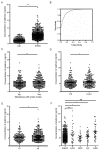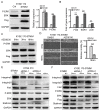Overexpression of stathmin plays a pivotal role in the metastasis of esophageal squamous cell carcinoma
- PMID: 28977901
- PMCID: PMC5617461
- DOI: 10.18632/oncotarget.18687
Overexpression of stathmin plays a pivotal role in the metastasis of esophageal squamous cell carcinoma
Abstract
Purpose: Esophageal squamous cell carcinoma (ESCC) is a serious malignant tumor that affects human health. We analyzed the correlation between serum stathmin level and ESCC and elucidated the molecular mechanisms of stathmin's promotion of ESCC cell invasion and metastasis.
Methods: Stathmin level in ESCC and healthy control serum were detected by enzyme-linked immunosorbent assay (ELISA), and the clinical parameters were analyzed. We established ESCC cells with stathmin overexpression or knockdown and then evaluated the effects of stathmin on invasion and metastasis in ESCC. Differentially expressed genes were analyzed by Human Transcriptome Array and confirmed by RT-PCR. The expression levels of the integrin family, focal adhesion kinase (FAK) and extracellular signal-regulated kinase (ERK) were detected by immunoblotting.
Results: Serum levels of stathmin were significantly higher in ESCC than in control serum and associated with lymph node metastasis, tumor stage and size. Furthermore, we found that stathmin promoted migration and invasion of ESCC cells in vitro and in vivo. In addition, we confirmed that the activation of the integrinα5β1/FAK/ERK pathway is increased in stathmin-overexpression cells and accelerates cell motility by enhancing cell adhesion ability.
Conclusion: Stathmin may predict a potential metastasis biomarker for ESCC.
Keywords: ERK; ESCC; FAK; integrinα5β1; stathmin.
Conflict of interest statement
CONFLICTS OF INTEREST The authors have declared that no competing interests exist.
Figures









Similar articles
-
A novel rapid quantitative method reveals stathmin-1 as a promising marker for esophageal squamous cell carcinoma.Cancer Med. 2018 May;7(5):1802-1813. doi: 10.1002/cam4.1449. Epub 2018 Mar 25. Cancer Med. 2018. PMID: 29577639 Free PMC article.
-
Stathmin overexpression identifies high risk for lymphatic metastatic recurrence in pN0 esophageal squamous cell carcinoma patients.J Gastroenterol Hepatol. 2014 May;29(5):944-50. doi: 10.1111/jgh.12498. J Gastroenterol Hepatol. 2014. PMID: 24372619
-
Profiling of differentially expressed cancer-related genes in esophageal squamous cell carcinoma (ESCC) using human cancer cDNA arrays: overexpression of oncogene MET correlates with tumor differentiation in ESCC.Clin Cancer Res. 2001 Nov;7(11):3519-25. Clin Cancer Res. 2001. PMID: 11705871
-
Clinical significance of serum matrix metalloproteinase-13 levels in patients with esophageal squamous cell carcinoma (ESCC).Eur Rev Med Pharmacol Sci. 2014;18(4):509-15. Eur Rev Med Pharmacol Sci. 2014. PMID: 24610617
-
Stathmin in Cell Proliferation and Cancer Progression.Cancer Genomics Proteomics. 2005 Jul-Aug;2(4):227-237. Epub 2005 Jul 1. Cancer Genomics Proteomics. 2005. PMID: 31394711 Review.
Cited by
-
Tumor-associated macrophages-educated reparative macrophages promote diabetic wound healing.EMBO Mol Med. 2023 Feb 8;15(2):e16671. doi: 10.15252/emmm.202216671. Epub 2022 Dec 21. EMBO Mol Med. 2023. PMID: 36541165 Free PMC article.
-
A novel rapid quantitative method reveals stathmin-1 as a promising marker for esophageal squamous cell carcinoma.Cancer Med. 2018 May;7(5):1802-1813. doi: 10.1002/cam4.1449. Epub 2018 Mar 25. Cancer Med. 2018. PMID: 29577639 Free PMC article.
-
The role of stathmin expression in the differential diagnosis, prognosis, and potential treatment of ovarian sex cord-stromal tumors.Diagn Pathol. 2024 Aug 30;19(1):118. doi: 10.1186/s13000-024-01541-x. Diagn Pathol. 2024. PMID: 39215355 Free PMC article.
-
Clinical significance of tumor necrosis factor receptor 2 in middle and lower thoracic esophageal squamous cell carcinoma.Oncol Lett. 2018 Sep;16(3):2971-2978. doi: 10.3892/ol.2018.8998. Epub 2018 Jun 20. Oncol Lett. 2018. PMID: 30127886 Free PMC article.
-
Oncoprotein 18 is necessary for malignant cell proliferation in bladder cancer cells and serves as a G3-specific non-invasive diagnostic marker candidate in urinary RNA.PLoS One. 2020 Jul 2;15(7):e0229193. doi: 10.1371/journal.pone.0229193. eCollection 2020. PLoS One. 2020. PMID: 32614890 Free PMC article.
References
-
- Torre LA, Bray F, Siegel RL, Ferlay J, Lortet-Tieulent J, Jemal A. Global cancer statistics, 2012. CA Cancer J Clin. 2015;65:87–108. - PubMed
-
- Qiu H, Mao Y, Gu Y, Zhu J, Wang Y, Zeng J, Huang N, Liu Q, Yang Y. The potential of photodynamic therapy to treat esophageal candidiasis coexisting with esophageal cancer. J Photochem Photobiol B. 2014;130:305–309. - PubMed
-
- Gupta GP, Massagué J. Cancer metastasis: building a framework. Cell. 2006;127:679–695. - PubMed
LinkOut - more resources
Full Text Sources
Other Literature Sources
Miscellaneous

